The Tinkathia System or Teen Kathia System (Hindi: three Kathas ), was an economic policy enforced by the East India Company in India. It was practiced largely in Eastern India and in states such as Bihar. The Tinkathia System was challenged by the Champaran Satyagraha led by Mahatma Gandhi, this in turn became a watershed moment in the Indian independence movement and it was based on that peasants had to grow indigo on the 3 parts of the land out of 20 parts.
In other words, a farmer had to grow Indigo in 3 Katha out of 20 Katha (1 Bigha= 20 Katha). In Patna and nearby areas, 1 Katha is equals to 1,361.25 square feet or 151.25 square yard.
In the 17th and 18th century, most of Eastern India came under the rule of the East India Company. India, then, was a major producer of spices and dyes, primarily Indigo. The trade of Indigo was a major business. Several Agency Houses were involved in the Indigo trade. The East India Company compelled Indian farmers to grow cash crops like Indigo which severely affected their livelihoods. [1]
The term Tinkathia literally means three Katha, which is a unit of measurement for land used in India, Nepal and Bangladesh. [1]
In Indian units of measurement, each Bigha is sub-divided into twenty Katha. The Tinkathia System forced Indian peasants to grow only Indigo on three out of every twenty Katha. [1]
In his autobiography, Mohandas Gandhi described his visit to Patna and other areas of Bihar where the Tinkathia system and forced cultivation of Indigo was practiced: [2]
The Champaran tenant was bound by law to plant three out of every twenty parts of his land with indigo for his landlord. This system was known as the tinkathia system, as three kathas out of twenty katha had to be planted with indigo.
The Tinkathia System which had been in existence for about a century was thus abolished and with it the planters’ raj came to an end. The riots, who had all along remained crushed, now somewhat came to their own, and the superstition that the stain of indigo could never be washed out was exploded.
— M K Gandhi [3]
The Tinkathia System was finally abolished after the Champaran Satyagraha led by Mahatma Gandhi.

Rajendra Prasad was an Indian politician, lawyer, journalist and scholar who served as the first president of India from 1950 to 1962. He joined the Indian National Congress during the Indian independence movement and became a major leader from the region of Bihar and Maharashtra. A supporter of Mahatma Gandhi, Prasad was imprisoned by British authorities during the Salt Satyagraha of 1930 and the Quit India movement of 1942. After the constituent assembly 1946 elections, Prasad served as 1st Minister of Food and Agriculture in the central government from 1947 to 1948. Upon independence in 1947, Prasad was elected as President of the Constituent Assembly of India, which prepared the Constitution of India and served as its provisional Parliament.

West Champaran is an administrative district in the state of Bihar in India, located just 60 km (37 mi) west of Birgunj. It is the largest district in Bihar with an area of 5,228 km²(2,019sq mi). It is a part of Tirhut Division. The district headquarters are located in Bettiah. The district is known for its open border with Nepal. One of the major location in West Champaran is Kumar Bagh for SAIL Special Processing Unit and Bhitiharwa where Mahatma Gandhi started Satyagrah Aandolan.
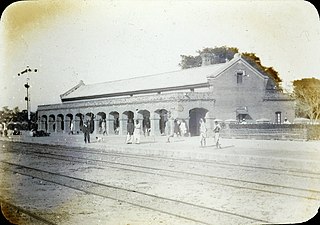
East Champaran is an administrative district in the state of Bihar in India.The district headquarters are located at Motihari. Prior to 1st Dec 1977, there was a single district called "Champaran". On 1 December 1977, the district was divided into 2 parts East Champaran and West Champaran. In early days the land of East Chamapran was ruled by different kingdoms as Videha, Sunga, Kanvas. It is also believed that Champaran used to be a major part of King Janak's empire. Mahatma Gandhi started his famous Satyagraha movement from here.

Motihari is a city and headquarters of East Champaran district in the Indian state of Bihar. It is located 80 kilometres west of Muzaffarpur and 152 kilometres northwest of the state capital Patna. In early days the land of Motihari was ruled by different kingdoms as Videha, Sunga, Kanvas. It is also believed that Champaran used to be a major part of King Janak's empire. Mahatma Gandhi Started his famous Satyagraha movement from here.

All India Kisan Sabha, is the peasant or farmers' wing of the Communist Party of India, an important peasant movement formed by Sahajanand Saraswati in 1936.
Champaran is a region of Bihar in India. It is now divided into an East Champaran district and a West Champaran district.

Gandhi Maidan is a historic ground in Patna, near the banks of the Ganges River, in Bihar, India. The Golghar falls to its west. During the period of 1824–1833, under British rule, it was used as a golf course and horse racing track and was called Patna Lawns. It is spread across 60 acres of land. It has a great political significance as well.
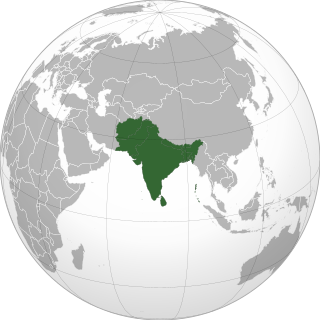
The history of Bihar is one of the most varied in India.Chirand, on the northern bank of the Ganga River, in Saran district, has an archaeological record dating from the Neolithic age. Regions of Bihar—such as Magadha, Mithila and Anga—are mentioned in religious texts and epics of ancient India. Mithila is believed to be the centre of Indian power in the Later Vedic period. Mithila first gained prominence after the establishment of the ancient Videha Kingdom. The kings of the Videha were called Janakas. A daughter of one of the Janaks of Mithila, Sita, is mentioned as consort of Lord Rama in the Hindu epic Ramayana. The kingdom later became incorporated into the Vajjika League which had its capital in the city of Vaishali, which is also in Mithila.
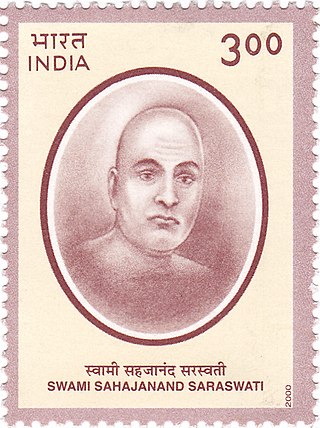
Sahajanand Saraswati was an ascetic, a nationalist and a peasant leader of India. Although born in United Provinces, his social and political activities focussed mostly on Bihar in the initial days, and gradually spread to the rest of India with the formation of the All India Kisan Sabha. He had set up an ashram at Bihta, near Patna, Bihar carried out most of his work in the later part of his life from there. He was an intellectual, prolific writer, social reformer and revolutionary.
Brajkishore Prasad (1877–1946) was a lawyer inspired by Mohandas Gandhi during the Indian Independence Movement.
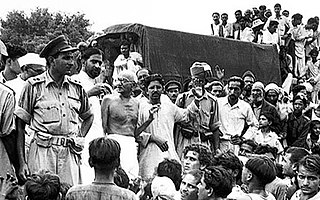
The Champaran Satyagraha of 1917 was the first satyagraha movement led by Mahatma Gandhi in British India and is considered a historically important rebellion in the Indian independence movement. It was a farmer's uprising that took place in Champaran district of Bihar in the Indian subcontinent, during the British colonial period. The farmers were protesting against having to grow indigo with barely any payment for it.
The bigha or beegah is a traditional unit of measurement of area of a land, commonly used in northern & eastern India, Bangladesh and Nepal. There is no "standard" size of bigha and it varies considerably from place to place.

Anugrah Narayan Sinha, known as Bihar Vibhuti, was an Indian nationalist statesman, participant in Champaran Satyagraha, Gandhian & one of the architects of modern Bihar, who was the first Deputy Chief Minister and the Finance Minister of the Indian state of Bihar (1946–1957). He was also a Member of the Constituent Assembly of India, which was elected to write the Constitution of India and served in its first Parliament as an independent nation. He also held a range of portfolios including Labour, Local Self Government, Public Works, Supply & Price Control, Health and Agriculture. A.N. Sinha, affectionately called Anugrah Babu, was a very close associate of Mahatma Gandhi during the freedom struggle movement and worked with Bihar Kesari Sri Krishna Sinha to lead the Gandhian movement in Bihar. One of the leading nationalists in the Indian independence movement from Bihar after Dr Rajendra Prasad, he was elected as the Congress Party deputy leader in the state assembly to assume office as first Deputy Chief Minister cum Finance Minister of independent Bihar, and re-elected when the Congress Party won Bihar's first general election with a massive mandate in 1952.
A katha is a unit of area mostly used for land measurement in India, Nepal, and Bangladesh. After metrication in the mid-20th century by these countries, the unit became officially obsolete. But this unit is still in use in much of Bangladesh, Northern India, Eastern India and Nepal. The measurement of katha varies significantly from place to place.
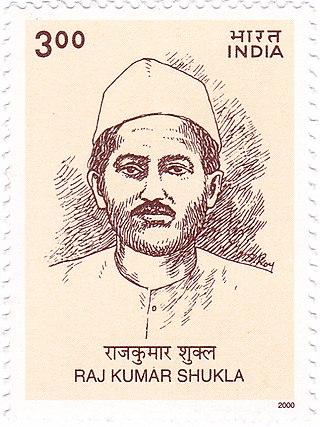
Raj Kumar Shukla was the person who convinced Mahatma Gandhi to visit Champaran which later led to the Champaran Satyagraha. Shukla at the time worked under Hafiz Din Mohammad and was sent to meet Gandhi.

26°41′N85°10′EDhaka Assembly constituency is an assembly constituency in the Indian state of Bihar, in Purvi Champaran district.
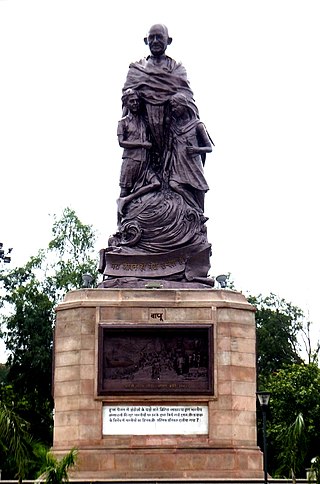
The statue of Mahatma Gandhi in Gandhi Maidan, Patna, is a public monument of India's father of Nation Mahatma Gandhi. The statue is the world's tallest bronze statue of Mahatma Gandhi. It was unveiled on 15 February 2013 by the then chief minister of Bihar, Nitish Kumar. It was established by Government of Bihar at a cost of ₹35 crore. The second tallest Gandhi statue turuvanur Chitradurga taluk and district karnataka
Bapudham Motihari Railway Station is a major railway station in Motihari through which 2 lines pass one towards Muzaffarpur and other towards Sitamarhi via Sheohar, it lies in the headquarter city of East Champaran district of Bihar. Its station code is BMKI. The station mainly consists of four platforms and acts as the main station in the city of Motihari, which is being developed under 'The Amrit Bharat Station Scheme' and to celebrate 150 years of Mahatama Gandhi. In February 2022, the Indian Railways had planned to set up a railway station Development Corporation (RSDC) that would work on improving the major railway stations, including Bapudham Motihari, by building and improving passenger amenities.[4] Under the development scheme, major development works are going on Bapudham Motihari. Separate air conditioned waiting lounge, free WiFi facility, IRCTC food court and many facilities are going to be available on Bapudham Motihari at the end of 2024. To enhance the security of this station, a metal detector and baggage handling system will be installed soon.

The Kheda Satyagraha of 1918 was a satyagraha movement in the Kheda district of Gujarat in India organised by Mahatma Gandhi during the period of the British Raj. It was a major revolt in the Indian independence movement. It was the second Satyagraha movement, which was launched 7 days after the Ahmedabad mill strike. After the successful Satyagraha conducted at Champaran in Bihar, Gandhi organised the movement to support peasants who were unable to pay the revenue because of famine and plague epidemic.

Maulana Mazharul Haque was an educator, lawyer, independence activist of the Indian National Movement.